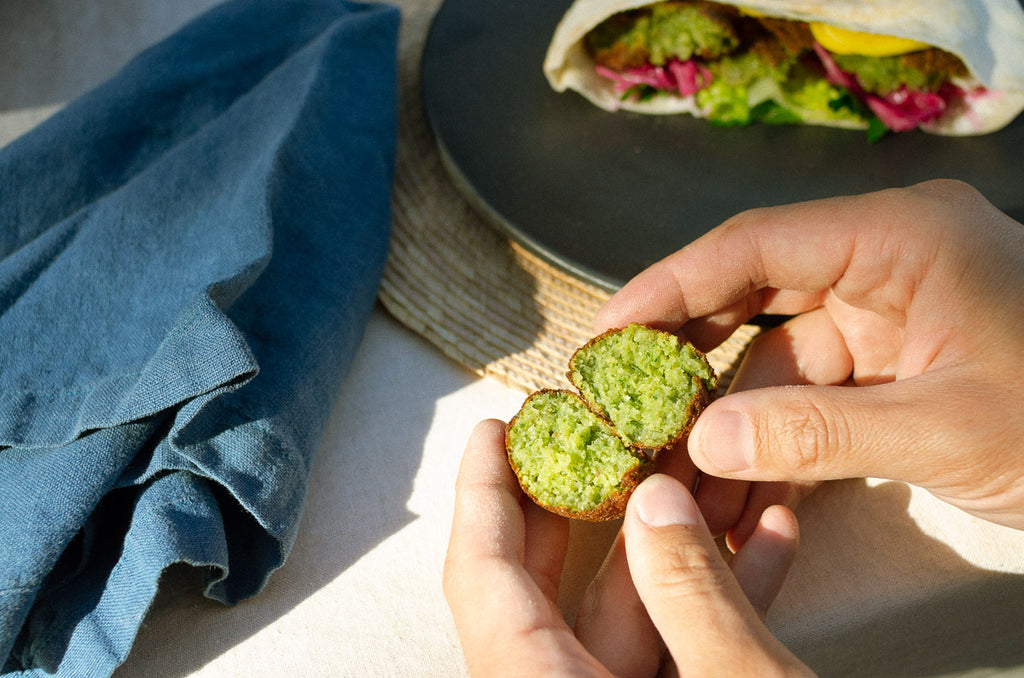I recall a series of late nights with a group of friends, when after a couple of drinks we would reminisce, as if they were one night stands, the great falafels we had eaten around the world. “Paris...best I ever had,” and so on.
For the last year or so we had toyed with the idea of a homemade version. We had started with a boxed mix from the store, which captivated us for a time. Ian was the first to imagine we might make them entirely from scratch, working our way through a wholesale sack of garbanzos we prized from Restaurant Depot in the depths of quarantine. Wanting a break from the incessant hummus we tried it, and the results were on another level. Falafel has the feeling of both a survival food, being made of dried beans, and a great indulgence, being fried, so it was perfect for those days of lockdown when we needed both.
Among the caravanserai of East Hollywood I heard tell of an Egyptian version called ta’ameya that uses, among many herbs and alliums, fava beans instead of garbanzo. I have peeled enough fava beans to know they’re worth the effort. They have a robust flavor I imagined asserting itself more than the subtle garbanzo. This was confirmed in advance by an Egyptian gentleman who, taking a long drag on his shisha, assured me that ta’ameya was better “in every way.”
I did my usual scramble for ingredients, to the farmer’s market and Super King, where I was pleased to learn that peeled, split favas are now easy to find. Soaking the beans overnight, I blended them with the greens in the proportions recommended by yet another Egyptian gentleman and fried the little guys outside on the patio. Prepped the night before, the ta’ameya make the perfect party food, as they fry up in great quantities in just a few minutes and disappear just as quickly. The flavor of the herbs, fresh and vibrant green, took me to another place entirely.
This recipe is sized for a party, but is easily halved and can also be refrigerated or frozen in separate batches.

Ta'ameya
Serves 10-12
1 lb dried split fava beans
1 bunch scallions, roughly chopped
1 medium leek, white and pale green parts only, roughly chopped
1 bunch cilantro
1 bunch parsley
4 cloves garlic
1 tbsp salt
2 tsp ground coriander
1 tsp cumin
1 tsp cayenne (optional)
Soak the fava beans in water overnight or for at least 8 hours. Drain well.
Add all of the ingredients to the bowl of a food processor and blend well to a fine consistency. The whole batch is too large for a home food processor, so I like to do it in 3 or 4 batches, adding a bit of each ingredient to each batch and then mixing it all up well in a large bowl. You could also process the beans, scallions, leek, and herbs separately and mix together at the end.
To fry, add about 4 cups of oil to a pot and heat to about 350 F over medium-high heat. You can test the oil temperature with a small pinch of falafel mix—it should start to sizzle immediately. Form the falafel balls with a small scoop (about 1.5 oz) or a spoon and your hands. They should be about 2-3 tablespoons in volume. Drop each ball into the oil, being careful not to overcrowd the pan, and fry for a few minutes until brown. Remove each with a scoop as they finish, and repeat for successive batches.
As an alternative, you could also bake the falafel, though it won't get as crispy. Preheat your oven to 450 F. Oil a baking sheet (an iron one will brown better) well with a high heat oil like avocado. Shape your falafel into more of a flattened patty shape and place onto the prepared sheet. Make sure to space them at least 2 inches apart so that they get crispy and don't steam. Brush the tops with more oil, then bake for about 10 minutes until the bottoms have browned. Flip and repeat on the other side.
Serve hot and fresh.


